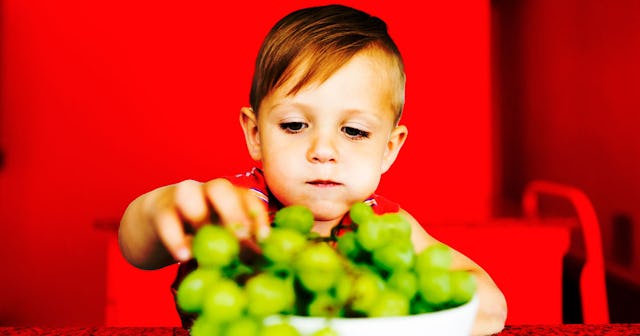There’s A Correct (And Incorrect) Way To Cut Grapes For Kids

Hands down, one of my scariest parenting moments was when my son choked. He was about one-and-a-half and was happily chowing down on apple slices, something he’d eaten successfully before.
Everything was fine, until it wasn’t. Suddenly, he began coughing and choking on the apples, and making wheezing sounds like he wasn’t breathing correctly. On the advice of a friend, I tossed him over my leg and began gently pounding his back. Soon enough, an apple slice flew right out of his mouth, and all was fine.
Well, he was fine, but I wasn’t. I felt like a terrible mother because I had let this happen. I didn’t realize how many apples he had been eating, and I incorrectly believed he would handle eating whatever he wanted, simply because nothing bad had ever happened before when he ate them. (I’ve since learned that any raw, firm fruits or veggies, like apples, have the potential to be a choking hazard for little ones.)
After that incident, I became hyper aware of the dangers of choking. I went back to feeding my son mostly softer foods that he could chew easily. I didn’t let him suck on hard candies for many years, popcorn was a big no for a long time, and I religiously cut up any small, round foods he ate, like blueberries and grapes.
I thought I knew everything about choking hazards, until recently, when I learned something I never knew. According to Mini First Aid, first aid experts based out of the U.K., there’s a correct (and incorrect) way to cut up any round foods you are feeding your little one—such as grapes, cherry tomatoes, olives, etc.
It turns out that cutting them in half won’t suffice. If you really want to protect your child from choking, you’ve got to cut grapes (and other round foods) lengthwise. Mini First Aid’s Facebook post explains this in greater details, along with a very helpful pic of what to do, and what not to do.
As Mini First Aid explains, little kids don’t have all their teeth yet, they aren’t that great at swallowing, and have really narrow airways. The Academy Of American Pediatrics (AAP) verifies this as well, explaining that it’s for these reasons that choking is a leading cause of death of children under the age of three. Even though many kids choke on non-food objects, such as small toys, 50% of choking episodes in kids involve food, according to the AAP.
GlobalStock/Getty
Round and cylindrical foods are one of the most dangerous foods for little ones. They can get lodged tightly into your child’s throat and can completely block their airways, explains the AAP. Hot dogs are the worst culprits for this, but whole grapes aren’t too far behind. Other big “nopes,” include hard sucking candies, peanuts, other nuts, uncooked carrots, apples, marshmallows, and meat sticks.
And because a picture is worth a thousand words, I present to you an X-ray of a five-year-old boy who had a grape lodged in his throat. You can see that the grape is the perfect size to get stuck in a young child’s airway. Thankfully, this child survived, but apparently needed surgery to get that sucker out. YIKES.
I think most of us are aware of the hazards of feeding our kids small round objects like grapes. But I think many of us (me, for sure!) didn’t realize that slicing them in half just isn’t sufficient.
Mini First Aid explains in their post that you should never cut grapes in half. Instead, they should be cut lengthwise, and “ideally into quarters.” The Canadian Paediatric Association also advises that grapes should be cut lengthwise, and recommends that hot dogs and sausages be cut in the same way. The AAP says that whole grapes should never be fed to young children, and that all foods be cut “no larger than one-half inch.”
Who knew, right? I definitely thought that cutting grapes in half would be good enough, but clearly that’s not the case. They need to be thinner for our little ones, and need to be cut in such a shape so that they won’t get stuck in their airways. Totally makes sense when you think about it, and especially with a visual illustration of the concept!
It can definitely feel overwhelming and stressful when you hear about all these very minute and particular details about how to keep your kids safe. It’s easy to feel like a bad parent just because you weren’t aware of these things, and weren’t quite doing it right. But acquiring new info is a good thing (and trust me, it’s an ongoing process when you are a parent).
And when it comes to something as common and potentially devastating as choking, it’s always, always, better to be safe than sorry.
This article was originally published on